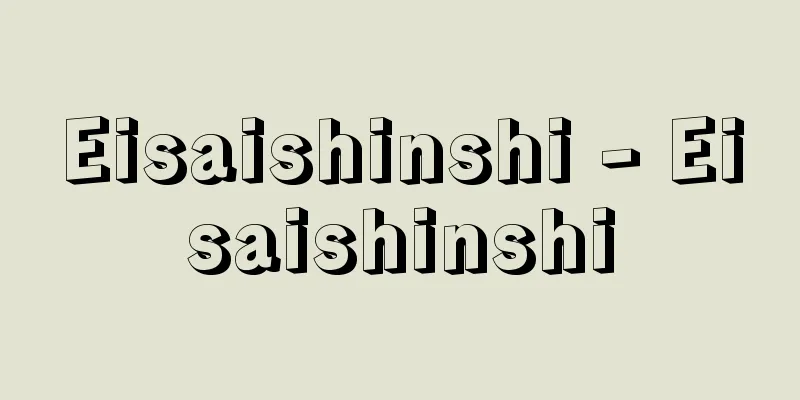Kiyomotobushi - Kiyomotobushi

|
It is a type of traditional Japanese music, and is the name of a school of Bungo-style Joruri. It is the last of the three schools of Bungo Joruri (Tokiwazu, Tomimoto, and Kiyomoto), and its founder was Kiyomoto Enjudayu. Okamura Kichigoro, who was a disciple of the first Tomimoto Itsukidayu (later Shimizu Enju), a senior disciple of Tomimoto Buzennojo, who established the Tomimoto-bushi school in 1748 (Kan'en 1), succeeded him as the second Saigūdayu. After the death of his teacher (1802), Yoshigoro fell out with the head of the school, Bungodayu II, and he withdrew from the entertainment world for a time. However, in 1812 (Bunka 9), Nakamura Utaemon III welcomed him to perform at the Nakamura-za theater, where he resumed his performance in the nagauta dialogue piece "Mata Kuru Harusuna no Tanemaki" under the name Bungoji Kiyomidayu. In 1814, he performed the joruri piece "Megumi no Hanayoshi no Shui" at the Ichimura-za theater under the name Kiyomoto Enjudayu, and thus the first school of Kiyomoto-bushi was born. The founder was a man of natural beauty, and with Kiyozawa Mankichi (later renamed Kiyomoto Saibei) on the shamisen, he created a succession of masterpieces, such as "Yasuna," "Tobae," "Kasane," and "Kairaishi," steadily solidifying the foundation of the emerging school. In 1824 (Bunsei 7), he shaved his head and changed his name to Enjusai, but was killed by an assassin the following year. His son Misajiro (formerly Eijudayu), who succeeded him as the second head of the school, made full use of his beautiful voice, which surpassed that of the first head, and developed a style of storytelling that further emphasized the spirit of sophistication that reflected the common people of the first head's Kasei period (1804-1830) through the use of solo and double recitation. In addition, he actively incorporated popular folk songs of the time into his songs, and refined his style to cater to the tastes of the times, thereby consolidating the position of his school and overwhelming the other two schools. For a period in the latter half of the Tenpo era (1830-1844), he also devoted himself to Kiyomoto-bushi, a form of zashiki joruri that was separate from theater music. After he adopted the name Taibei in 1845 (Koka 2), he further solidified the school's position. Saito Gennosuke, later the 4th, who was adopted by the daughter of the 2nd head of the Enju, Kawatake Shinshichi (Mokuami), recognized his skills and repaid his acquaintance with him, trusting him deeply. They formed a partnership and performed in "Umeyanagi Nakayoizuki" and then "Yukari no Irohagi no Murasaki," which was a huge success, and since then, the 4th head of the Enju, Enju, used Kiyomoto in Mokuami plays for a total of about 100 pieces. In addition, the idea of "foreigner's joruri," in which actors perform gestures to accompany joruri that is being performed in a nearby house or in another room, was well received, and outstanding representative pieces such as "Yuudachi," "Karigane," and "Fudekou" were born. However, since its inception, Kiyomoto-bushi has been passed down and told with an eye on the commonness and spirit of the common people, and as a result, it has often lacked elegance. The 5th Enjudayu, who was adopted by the 4th, was keenly aware of the changes of the times, changed the style of playing to a more elegant and delicate style, and led the way in improving the school's social status, shifting the demographic of its enthusiasts and achieving his goal. However, in 1922 (Taisho 11), the 3rd Umekichi, who played alongside the 5th Umekichi along with the 2nd Umekichi, parted ways with the school and founded the Kiyomoto school, which led to the school splitting into two factions: the Takanawa school (Enju school) and the Akasaka school (Umekichi school). After the death of the 5th Enjudayu, his grandson Seido succeeded as the 6th in 1948 (Showa 23), and in 1980 the 3rd Umekichi succeeded the 2nd Jubei, while his grandson Seinosuke took on the name of the 4th Umekichi. It was not until 1964 that the establishment of the Kiyomoto Association was finally agreed upon, with Enjudayu VI appointed as chairman and Jubei II as honorary chairman. In July 1966, one month after Jubei's death, a joint concert was held to reconcile the two factions, but the Akasaka faction subsequently left the Kiyomoto Association, and the group split once again. A distinctive feature of Kiyomoto-bushi is that vocalization and melody are more decorative than in other schools. It is colorful and elegant, with techniques such as "kaeshi" (a melody style in which the notes are lowered), a technique of starting with a high note and gradually transitioning to a lower note over the opening of the narration, "furidashi" and rolling the vocal cords to create a mnemonic effect, and pushing the end of the notes. The shamisen has a medium neck and produces a rich, moist, and soft sound. The tone has many expressions of speed, speed, strength, and weakness, and when making use of Joruri, the number of plectrums is few and modest, and the mabyoshi (interval beats) are sometimes played in a unique way to enhance the effect. Except when accompanying dance, care is taken to play in a high pitch so as not to interfere with strongly spoken works. [Kiyohiro Hayashi and Yukinori Moriya] "Study on Kiyomoto" by Ninchoji Tsutomu (1930, Shunyodo)" ▽ "Modern Japanese Music Directory: Kiyomoto Edition" by Machida Kasei and Ueda Ryunosuke (1967, Japanese Music and Dance Publishing Department)" ▽ "History of Edo Bungo Joruri" by Iwasa Shinichi (1968, Kuroshio Publishing) [References] | | | | | |Source: Shogakukan Encyclopedia Nipponica About Encyclopedia Nipponica Information | Legend |
|
邦楽の種目で、豊後(ぶんご)系浄瑠璃(じょうるり)の流派名。豊後三流(常磐津(ときわず)、富本(とみもと)、清元)とよばれるなかでも、最後に生まれた新しい浄瑠璃であり、清元延寿太夫(えんじゅだゆう)を始祖とする。1748年(寛延1)に富本節一流をたてた富本豊前掾(ぶぜんのじょう)の高弟、初世富本斎宮(いつき)太夫(後の清水延寿)の弟子となった岡村吉五郎が、2世斎宮太夫を継いだ。吉五郎は師の没後(1802)家元の2世豊前太夫と不和になり、一時は芸界から身を引いていたところ、1812年(文化9)3世中村歌右衛門(うたえもん)から中村座の興行に迎えられ、豊後路清海(ぶんごじきよみ)太夫を名のって長唄(ながうた)との掛合い『再春菘種蒔(またくるはるすずなのたねまき)』に再勤し、14年市村座の『御攝花吉野拾遺(めぐみのはなよしのしゅうい)』の浄瑠璃で清元延寿太夫と称し、ここに清元節一流が誕生した。初世は天性の美音家であり、清沢万吉(後に清元斎兵衛と改名)を立(たて)三味線に据え、『保名(やすな)』『鳥羽絵(とばえ)』『累(かさね)(かさね)』『傀儡師(かいらいし)』など、名曲を次々と創作して新興流派としての基盤を着実に固めた。24年(文政7)剃髪(ていはつ)し、延寿斎と改めたが、翌年刺客の凶刃に倒れた。 2世を継いだ実子巳三治郎(みさじろう)(前名栄寿太夫)は、初世をしのぐ美声を存分に生かして、独吟、二吟という形式によって、初世の化政(かせい)期(1804~30)の庶民性を反映した粋(いき)の精神をよりいっそう強調した語り口へと発展させた。これに加えて、当時流行の俗謡を積極的に曲中に取り入れるなど、時代の要望する嗜好(しこう)に迎合した曲風を練成することによって独流の体勢固めに徹して、他の2流を圧するまでに至った。天保(てんぽう)年間(1830~44)後半の一時期には、劇場音楽を離れた座敷浄瑠璃としての清元節にも心を尽くした。1845年(弘化2)太兵衛を名のってからは、流派の地位をさらに確固不動のものにした。2世の娘お葉の婿養子に迎えられた斎藤源之助、後の4世は、2世河竹新七(黙阿弥(もくあみ))に技量を認められ、その知遇に報いて深く信頼したことから、提携して『梅柳中宵月(うめやなぎなかもよいづき)』に、ついで『由縁色萩紫(ゆかりのいろはぎのむらさき)』へ出演、これが大好評で、以来、4世延寿太夫の清元が黙阿弥劇で用いられた総数は約100曲の多きにのぼった。それにまた、付近の家とか別の部屋で語る浄瑠璃にあわせて俳優が仕種(しぐさ)をする「余所事(よそごと)浄瑠璃」の趣向が図にあたり、『夕立』『雁金(かりがね)』『筆幸(ふでこう)』などの傑出した代表曲が生まれた。しかし、清元節は創成期以来、庶民階級の通俗と意気を眼目に置いて受け継がれ、語られてきた結果、格調において欠ける点が多かった。 4世の養子となった5世延寿太夫は、この時代の推移を敏感に察知し、上品繊細な奏法に改め、流派の社会的地位の向上確保に率先垂範し、愛好者の層の転換を図り、目的を達成した。だが1922年(大正11)2世梅吉ともども5世の相三味線を勤めた3世梅吉がたもとを分かち、清元流を創設するに及んで、高輪(たかなわ)派(延寿派)と赤坂派(梅吉派)の2派に分裂した。そして5世延寿太夫の没後、孫の清道が48年(昭和23)に6世を継ぎ、55年3世梅吉は2世寿兵衛を継承、孫の清之介が4世梅吉を襲名した。64年になってようやく清元協会設立の話がまとまり、6世延寿太夫が会長、2世寿兵衛が名誉会長に就任し、寿兵衛逝去のひと月後の66年7月、両派融和を図る合同演奏会が開催されたが、その後、赤坂派は清元協会を脱会、ふたたび分裂した。 清元節の特色として、発声および節回しには他流に比べて装飾技巧が多い。「カエシ」(節を下げておとす旋律型)、語り出しにかぶって高い音程から出てなだらかに低い音程へ移行する技法、「振り出し」や声帯を振動させころがすといった語呂(ごろ)をきかす技法、節尻(ふしじり)の押しなど、多彩で華麗である。三味線は中棹(ちゅうざお)で、豊かで潤いのある柔らかい音を身上とする。また音色に緩急強弱の表情が多く、浄瑠璃を生かすときには撥(ばち)数も少なく控え目で、間拍子(まびょうし)も独特のはずし方で効果を高める奏法がとられたりする場合もある。上調子(うわぢょうし)は、舞踊の伴奏の場合を除き、語物の色濃いものにはとくに障らないように留意してつきあっている。 [林喜代弘・守谷幸則] 『忍頂寺務著『清元研究』(1930・春陽堂)』▽『町田佳聲・植田隆之助著『現代・邦楽名鑑清元編』(1967・邦楽と舞踊出版部)』▽『岩沙慎一著『江戸豊後浄瑠璃史』(1968・くろしお出版)』 [参照項目] | | | | | |出典 小学館 日本大百科全書(ニッポニカ)日本大百科全書(ニッポニカ)について 情報 | 凡例 |
<<: Fish oil - gyoyu (English spelling) fish oil
Recommend
Masanaga Naito - Masanaga Naito
Year of death: October 17, 11 (December 7, 1634) Y...
Gama Oil Seller - Gama Oil Seller
A type of street vendor who sells ointments made f...
Tou - To
("To" is the idiomatic pronunciation of ...
blue Japanese oak
…In Japan, oak is often translated as kashi, but ...
Seppuku - Seppuku
A method of suicide by cutting one's stomach ...
tepe
…They are found mainly in Western Asia, Central A...
Thomson
[1] (Elihu Thomson) British-born American electric...
Miyagawa
[1] A river flowing northeast through central-sout...
Freedom of Assembly
In principle, freedom from being hindered or compe...
Ozeki Takamasu - Ozeki Takamasu
…The Ozeki clan originated from a powerful local ...
Chinese meaning - Karagokoro
… We have looked at examples of the use of 〈yamat...
Ministry of Finance Mint Bureau
…In addition to clan notes, private banknotes wer...
Fluxus - Furukusasu (English spelling) Fluxus
Fluxus was an expressive movement that developed ...
Xie Wen - CEO
A poet from the Southern Qi Dynasty in China. His...
bouquet
…It is also called flower design, a term that has...









